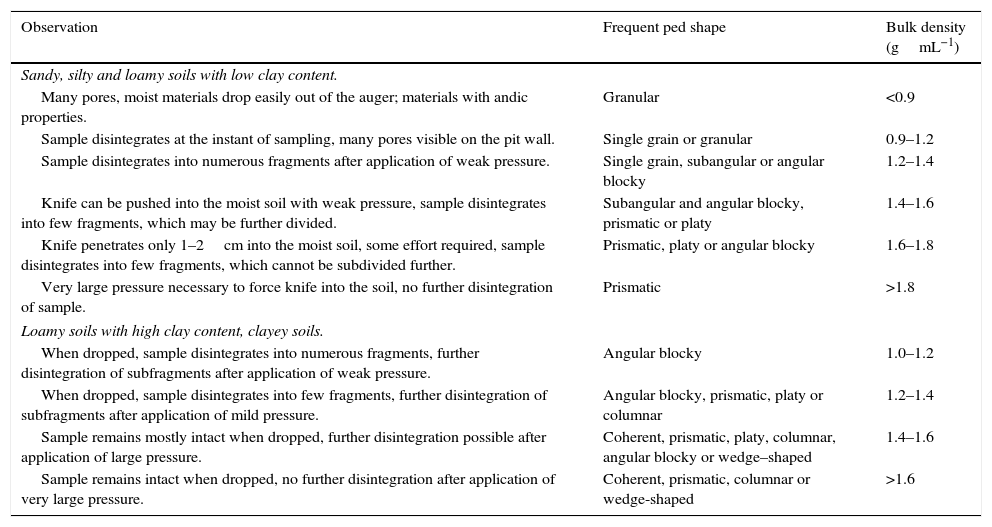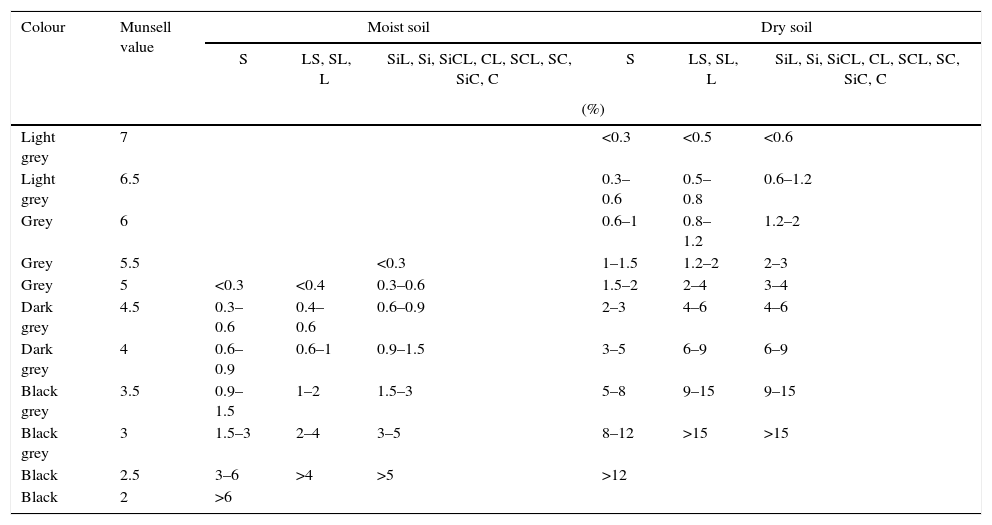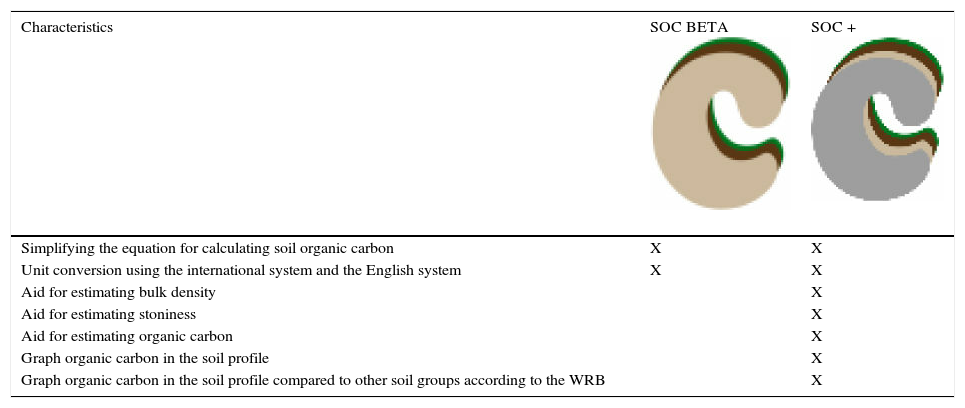In the world, researchers are working very intensively in the development of soil organic carbon (SOC) inventories. Soil organic carbon is very important because it constitutes the largest reservoir of carbon in terrestrial ecosystems. Maintaining and increasing soil carbon is an option to reduce the amounts of CO2 in the atmosphere, and thereby, to reduce or mitigate climate change. The SOC is now a topic of great interest hence it is recommended to know the amount of SOC along the profile to select and evaluate those areas that should be preserved. The aims of developing App SOC plus were to eliminate the calculate errors of SOC and to make a tool to estimate SOC in field. The common units of measurement of soil properties were employed: bulk density in mgmL−1, horizon thickness in centimetres, stoniness and organic carbon in percentage. The App SOC plus was developed in the Android platform. App SOC plus involves a three-step process: introduction of soil properties, calculation of SOC to horizon and soil profile, and conversion of units using the international and English systems. As a result, there will no longer be confusions with conversion units using App SOC plus; with App SOC plus the soil organic carbon can now be calculated or/and estimated because it provides instructions (aids) to estimate the soil properties necessary to calculate the SOC in the soil profile. You can save time in the calculation of SOC. App SOC plus is a tool for diagnosis in the field.
Intensive work is developed at a global, national and local level to elaborate the inventories of soil carbon because of its relation to the global climate change. Soil carbon is considered the largest carbon reservoir of the terrestrial ecosystems (Alvarez-Arteaga, Krasilnikov, & García-Calderón, 2012.) At a local level, areas of interest for the conservation may appear, such as the natural protected areas, the national parks and the biosphere reserves. These areas are valued because of the environmental services they offer to the society. The payment for these environmental services, among which the fixation of organic carbon stands out, is planned in some of these places the soil organic carbon calculation (Pérez, Ramírez, Bautista, & Jaramillo, 2013).
The study of soil organic carbon is now a subject of great interest, which is why it is recommendable to know the amount of soil organic carbon throughout the soil profile to select and value the areas that must be preserved.
Normally, miscalculations are shown in scientific meetings because of the unfortunate selection of the properties of the soil that is being measured, the way of expressing them with inappropriate units and because of miscalculations. Besides, the number of professionals who are not edaphologists interested in the measurement of SOC grows day by day.
The reasons to create App SOC plus are as follows: (a) normally, miscalculations are shown in scientific meetings because of the unfortunate selection of the properties of the soil that is being measured, the way of expressing them with inappropriate units and because of miscalculations; (b) the number of professionals who are not edaphologists interested in the measurement of SOC grows day by day; (c) the need to perform rapid field estimations.
The aims behind the creation of App SOC plus are (a) to decrease the miscalculations caused by the unfortunate selection of the properties of the soil, the application of the wrong equation and the inappropriate units, in which the results are expressed; (b) to offer the professionals who are not edaphologists a tool to measure the SOC; (c) to perform rapid field estimations.
2Materials and methods2.1App design and development platformApp SOC plus is an application designed for the estimation of soil organic carbon from its edaphic properties. This app is compatible with all mobile devices with an Android V 4.0 or the latest operating system. In order to create App SOC plus we used: (a) SDK, the software developer tool for Android and (b) IDE Eclipse as an integrated development environment. Both are open access tools. Interfaces were designed to allow compatibility with resolution in smartphones and tablets of 7′ and 10′ (Canós, Letelier, & Penadés, 2003).
2.2Soil organic carbon calculationIn order to calculate the soil organic carbon (SOC) the following formula is applied:
where SOC [Mgha−1]: organic carbon full profile; n: total number of horizons full profile; BDi [gmL−1]: bulk density of the horizon i; THi [cm]: thickness of the horizon i in cm; CRi [vol.%]: volume of coarse fragments by horizon i; Ci [%]: percentage of organic carbon horizon i.App SOC plus includes a simplified formula, in which the soil properties are shown in the common units in use.
App SOC plus makes it possible to calculate the organic carbon in an easy and rapid way. It is also possible to carry out estimations of the quantity of organic carbon by using the soil profile description on the field (it includes options for the estimation of the bulk density, stoniness and organic carbon on the field).
2.3Bulk density estimationThe bulk density is measured with a cylinder of a known volume which is inserted in each horizon, then it is dried and weighed right after (Jahn, Blume, Asio, Spaargaren, & Schad, 2006; Siebe & Jahn, 1996). When the horizon has a reduced thickness or it is too compact to insert the cylinder properly, it is possible to measure the soil density by means of the aggregate density by using the clod method (Gandoy, 1992; NOM, 2003.) In non-aggregated soils, it is recommended to use the core method (Gandoy, 1992).
In stony soils, such as the ones on the Yucatan Peninsula, which have high carbon content in fine earth but, at the same time, have scarce fine earth, it is necessary to measure the bulk density by digging a hole in the soil and collecting fine earth, thick fragments, and afterwards, measuring the volume by lining a plastic and by filling it with water, or by using the core method.
The key from Table 1 is used in order to make the bulk density estimation on the field.
Guidelines to estimate bulk density (FAO, 2006).
| Observation | Frequent ped shape | Bulk density (gmL−1) |
|---|---|---|
| Sandy, silty and loamy soils with low clay content. | ||
| Many pores, moist materials drop easily out of the auger; materials with andic properties. | Granular | <0.9 |
| Sample disintegrates at the instant of sampling, many pores visible on the pit wall. | Single grain or granular | 0.9–1.2 |
| Sample disintegrates into numerous fragments after application of weak pressure. | Single grain, subangular or angular blocky | 1.2–1.4 |
| Knife can be pushed into the moist soil with weak pressure, sample disintegrates into few fragments, which may be further divided. | Subangular and angular blocky, prismatic or platy | 1.4–1.6 |
| Knife penetrates only 1–2cm into the moist soil, some effort required, sample disintegrates into few fragments, which cannot be subdivided further. | Prismatic, platy or angular blocky | 1.6–1.8 |
| Very large pressure necessary to force knife into the soil, no further disintegration of sample. | Prismatic | >1.8 |
| Loamy soils with high clay content, clayey soils. | ||
| When dropped, sample disintegrates into numerous fragments, further disintegration of subfragments after application of weak pressure. | Angular blocky | 1.0–1.2 |
| When dropped, sample disintegrates into few fragments, further disintegration of subfragments after application of mild pressure. | Angular blocky, prismatic, platy or columnar | 1.2–1.4 |
| Sample remains mostly intact when dropped, further disintegration possible after application of large pressure. | Coherent, prismatic, platy, columnar, angular blocky or wedge–shaped | 1.4–1.6 |
| Sample remains intact when dropped, no further disintegration after application of very large pressure. | Coherent, prismatic, columnar or wedge-shaped | >1.6 |
Note: If organic matter content is >2%, bulk density has to be reduced by 0.03kgdm−3 for each 1% increment in organic matter content.
A measuring tape is used in order to obtain a horizon thickness measurement. The difficulty in the process appears when the boundary between the horizons is wavy, irregular or broken. In these cases, the average depth between the horizons must be registered.
The thickness is measured in centimetres.
2.5Stoniness or thick fragments volumeThe estimation of the stone fragments volume, also called stoniness, can be carried out by comparison to Fig. 1 (USDA, 2012). The estimation of this parameter is carried out horizon by horizon. It is recommended to work with a known surface (e.g. 100cm2) using a cord that would be adaptable to the different horizon thicknesses.
2.6Soil organic carbonIn order to measure the soil organic carbon in fine earth (sieved through a 2mm mesh) various methods are suitable. The common method is the wet oxidation method in an acid potassium dichromate solution; the reaction mixture temperature rises and 70% of the soil organic carbon is recovered (Nelson & Sommers, 1982).
The method of wet oxidation with potassium dichromate may be more efficient if external heat is applied to the reaction, since 100% of organic carbon will oxidize (Nelson & Sommers, 1982).
The most recommended method is the use of an auto-analysis equipment for total organic carbon; with this equipment, an oxidation by combustion is performed, the gases filter up and the CO2 is measured. 100% of the soil organic carbon is recovered with the use of this method. There are other methods to quantify the soil organic carbon by means of UV and infrared; nevertheless, they are not frequently used. In soils with inorganic carbon, its elimination must be taken into account. It will be carried out with some acid that will not interfere with the analysis method applied later.
The organic soil can be estimated on the field by using the guide in Table 2.
Guidelines to estimate soil organic carbon (FAO, 2006).
| Colour | Munsell value | Moist soil | Dry soil | ||||
|---|---|---|---|---|---|---|---|
| S | LS, SL, L | SiL, Si, SiCL, CL, SCL, SC, SiC, C | S | LS, SL, L | SiL, Si, SiCL, CL, SCL, SC, SiC, C | ||
| (%) | |||||||
| Light grey | 7 | <0.3 | <0.5 | <0.6 | |||
| Light grey | 6.5 | 0.3–0.6 | 0.5–0.8 | 0.6–1.2 | |||
| Grey | 6 | 0.6–1 | 0.8–1.2 | 1.2–2 | |||
| Grey | 5.5 | <0.3 | 1–1.5 | 1.2–2 | 2–3 | ||
| Grey | 5 | <0.3 | <0.4 | 0.3–0.6 | 1.5–2 | 2–4 | 3–4 |
| Dark grey | 4.5 | 0.3–0.6 | 0.4–0.6 | 0.6–0.9 | 2–3 | 4–6 | 4–6 |
| Dark grey | 4 | 0.6–0.9 | 0.6–1 | 0.9–1.5 | 3–5 | 6–9 | 6–9 |
| Black grey | 3.5 | 0.9–1.5 | 1–2 | 1.5–3 | 5–8 | 9–15 | 9–15 |
| Black grey | 3 | 1.5–3 | 2–4 | 3–5 | 8–12 | >15 | >15 |
| Black | 2.5 | 3–6 | >4 | >5 | >12 | ||
| Black | 2 | >6 | |||||
Note: If chroma is 3.5–6, add 0.5 to value; if chroma is >6, add 1.0 to value. S: sand; LS: loamy sand; SL: sandy loam; L: loam; SiL: silt loam; Si: silt; SiCL: silt clay loam; CL: clay loam; SCL: sandy clay loam; SC: sandy clay; SiC: silt clay; C: clay.
In App SOC plus, click first the App logo (new estimation) and insert the horizon key; subsequently, introduce the bulk density in gmL−1, the horizon thickness in cm, the stone volume or thick fragments in percentage (0–100), and finally, the soil organic carbon in fine earth (sieved through a 2mm mesh) expressed in percentage (Table 3). Afterwards, click “calculate horizon” which will be calculated in SOC and expressed in MgCha−1. Later, introduce the horizon data (Fig. 2). The total organic carbon in the soil profile appears at the bottom of the screen. Once the total SOC calculations are completed, it is possible to transform the units if necessary (Fig. 2).
Functions of the two versions of the App SOC.
| Characteristics | SOC BETA | SOC + |
|---|---|---|
| Simplifying the equation for calculating soil organic carbon | X | X |
| Unit conversion using the international system and the English system | X | X |
| Aid for estimating bulk density | X | |
| Aid for estimating stoniness | X | |
| Aid for estimating organic carbon | X | |
| Graph organic carbon in the soil profile | X | |
| Graph organic carbon in the soil profile compared to other soil groups according to the WRB | X |
It is possible to estimate the content of the soil organic carbon by using the functions to estimate the bulk density and organic carbon with tables. Besides, it is possible to obtain graphs from the carbon content throughout the profile and compare them with the organic carbon content of some soil groups provided by the WRB (Robert, 2002).
There is no similar tool to compare the efficiency of App SOC plus with.
3.2Quick calculationApp SOC plus performs an accurate calculation and shows a rapid performance of all its functions. By comparison, an experienced technician needs 70min to calculate one profile of five horizons with Excel; however, with App SOC plus the calculations are quickly finished in only 7min (Fig. 3). Since work time on the field is expensive, this difference in minutes is very valuable. The app is designed to behave as a field tool, with which calculations and estimations can be done quickly and reliably.
4ConclusionsWe have now a tool with the possibility to be used on the field which allows the fulfilment of a rapid diagnosis of the content of organic carbon in the soil profile with common measure units applied on the field; it eliminates possible mistakes when calculating or applying formulas and performs rapidly.
Knowledge of the content of organic carbon in the soil profile is of primary importance to link the soil usage with its environmental functions within the ecosystem or landscape and with other ecosystems and nearby landscapes.
Conflict of interestThe authors have no conflicts of interest to declare.
Francisco Bautista thanks Dirección General de Asuntos del Personal Académico (DGAPA) of Universidad Nacional Autónoma de México (UNAM) for the financial support for a sabbatical stay at CEBAS-CSIC in Spain. Angeles Gallegos and Eduardo García thank the financial support from Skiu.

















